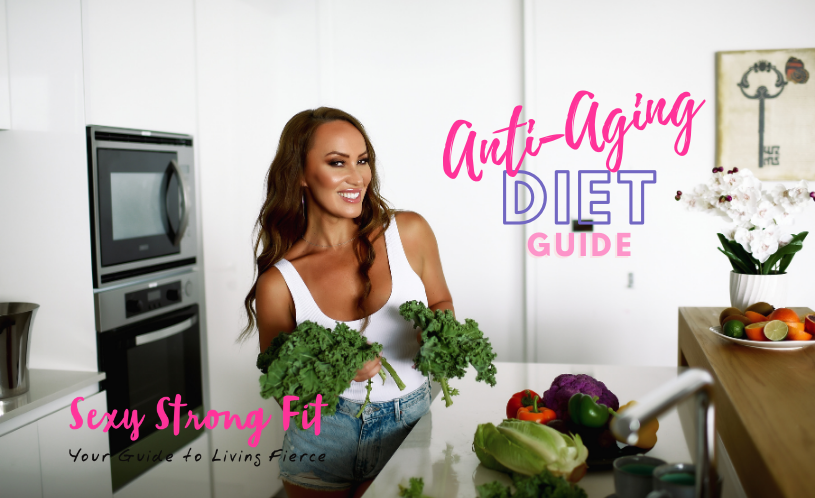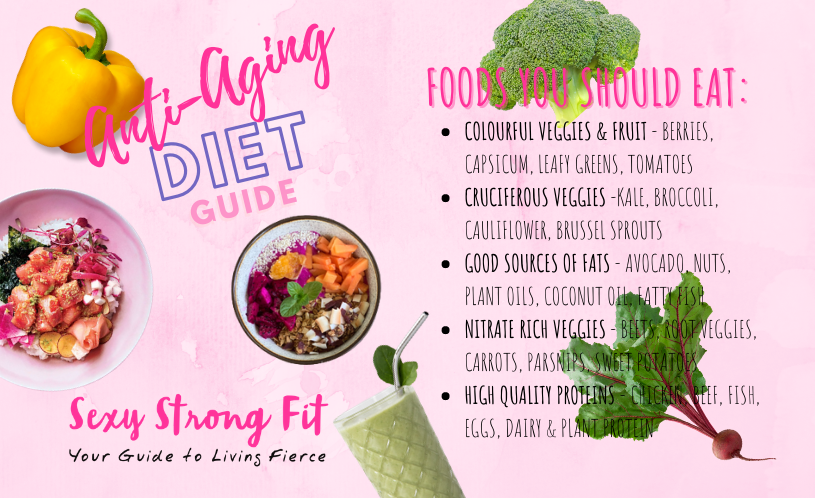Your diet is probably the single most important thing you can change when it comes to anti-aging. Now when I say the word diet, I don’t mean following some complicated, ultra restrictive diet. An anti-aging diet is all about following a consistent, healthy eating plan that includes plenty of natural, whole fresh food and eliminating processed ingredients such as sugar, flour and man-made fats! Let’s break it down into the diet structure, benefits, foods you need to include and what a 1-day anti-aging diet actually looks like!
Anti-Aging Diet Structure:
To keep my curves tight, my skin glowing and my body fit from the inside out for the last 20 or so years, here’s the diet structure I’ve followed, and you should too!
- Cut the Sugar – sugar is inflammatory, inflammation can cause your skin to age faster by hardening the skin and causing wrinkles. Sugar can also impact your mood; cause cyclic eating patterns and lead to belly fat! Stay away from this toxic ingredient. Not convinced – read more here.
- Up Your Protein Intake – reduce your carb intake to somewhere between 20 to 30% and up your protein intake to at least 40%. High protein diets help maintain your lean mass, which results in a faster metabolism and firmer body. As we get older we tend to lose our muscle mass, but it’s critical to help keep the body strong and protect our bones. Try Carb Cycling!
- Eat Your Antioxidants – eat more plants! I’m talking about vegetables and fruit! They’re full of natural vitamins, minerals, phytonutrients and antioxidants that help regulate our metabolism and fend off free-radical attack from stress, pollution and even the rays from the sun. Research has shown that those who eat plenty of plants have higher antioxidant capacity.
- Try Fasting, Calorie Reduction – eating less food, less often has been shown to result in a longer and higher quality of life. Eat somewhere between your basic calorie needs to the calories you need to maintain your current weight. Be intuitive to your eating and stop before you’re full, consider fasting a few times per week, or limiting your eating to only certain hours of the day.
- Eat More Fiber – high fiber diets help keep the gut healthy, why is that important? The gut is a direct link to our immune health, not to mention it can also help control absorption of excessive toxins and hormones that can cause damage throughout the body. A healthy diet should provide 25 g of fibre daily, Fill up on leafy greens, and hearty veggies like broccoli, cauliflower and kale.
What are the Best Foods to Include?
Your diet needs to include an abundant amount of natural, fresh foods, closest to it’s natural form. Skip over anything made with white sugar, white flour – yes that means bread and pasta, processed meats, cheeses and fats.
Colorful Vegetables & Fruits – the more color the better! Choose from orange, yellow, purple and red colored veggies and fruit such as citrus fruit, carrots, squashes, cabbage, blueberries, blackberries and capsicum, which provide an assortment of antioxidants along with Vitamin A and C. These nutrients are good for collagen production, a main component of the structures of the skin, as well as help protect the skin from sun damage.
Cruciferous Vegetables – including broccoli, kale, cauliflower and cabbage are high in fiber, folate, vitamin C and K, as well as calcium and lutein. They also contain the anti-estrogen compound Indole-3-Carbinol, which can help reduce high levels of estrogen and help control hormone levels in the body. This group of vegetables helps support collagen production, bone health, estrogen balance, detoxification of the gut and even help protect the brain against the effects of aging.
Good Sources of Fat – the body needs good fats to help mediate the inflammatory response, production of hormones, skin tissue repair, protect skin from damage and help protect the brain. Healthy sources of fat include nuts such as almonds, walnuts, cashews, as well as seeds including chia, pumpkin, sunflower, flax and sesame. Other great sources include fatty fish, avocado, olives and olive oil.
Nitrate Rich Vegetables – Root vegetables are high in natural sources of nitrates. Nitrates help stimulate blood flow and circulation throughout the body. This is important for heart health, exercise performance, lowering blood pressure, stimulating brain function and reducing cell damage.
High Quality Proteins – the body needs high quality, complete proteins for the body to function optimally. Protein helps build and repair muscles, keeps the structure of our skin firm and tight, and is an important component of enzymes and hormones involved in the metabolism. In addition, the more lean muscle you have, the higher your metabolism! High quality proteins include chicken, turkey, lean meats, fish, whole eggs and hormone-free, grass fed dairy!
Benefits of Eating an Anti-Aging Diet:
- Firmer, Tighter, Glowing Skin
- Better Body Composition, More Lean Muscle, Less Fat and Higher Metabolism
- Improved Hormonal Balance and Fertility
- Protection from Environmental Toxins, Skin Damage from UV rays
- Sharper Memory, Better Clarity and Brain Function
- Healthier Gut, Reduced Inflammation and Better Immune Response
Eat These Foods:
- Quinoa, Brown Rice, Farrow, Bulgur
- Beans, Legumes, Peas
- Cruciferous Vegetables
- Leafy Green Vegetables
- Squashes
- Root Vegetables
- Berries
- Apples
- Citrus Fruit
- Salmon, Tuna
- Sole, Cod, Tilapia
- Lean Meat
- Free Range Whole Eggs & Egg Whites
- Hormone Free Plain Greek Yoghurt
- Coconut Yoghurt
- Halloumi, Paneer, Feta
- Whey Protein
- Avocado
- Nuts, Nut Butters
- Chia, Sesame, Pumpkin Seeds
- Tahini
- Seed Oils
- Olives, Olive Oil
- Coconut Oil
- Nut Milks
Do Not Eat These Foods:
- Processed Meats
- Processed Cheeses
- Fast Foods
- White Breads
- Pasta
- Bread, Pastries, Muffins
- Boxed Cereal
- Granola Bars
- Fruit Based Yoghurts
- Processed Fats, Vegetable Fats
How Many Calories Do You Need? What are Your Macronutrients?
The number of calories you require will be determined by a number of factors including your age, weight, height and activity level. Go here to determine your calorie levels. Remember that this is just a guide; your calories may increase or decrease depending on your body, how active you are and how fast you metabolize food.
For your macronutrient breakdown, you will need 40% of your calories from protein and 30% from each carbs and fats. The amount of carbs and fats in your diet can be adjusted depending on whether you want to lose or gain weight. If you’re carb sensitive, have a harder time losing weight lower your carbs down to 20%, and up your protein and or fat calories.
1-Day Anti-Aging Diet Breakdown:
Breakfast:
- 2 Whole Scrambled Eggs
- Half Avocado
- Cucumber
- Tomato
- 5 g Olive Oil
- Lime
Snack:
- 25 g Roast Almonds
- Apple
Lunch:
- 150 g Grilled Chicken Breast
Kale Salad:
- Kale
- Romaine
- Grated Carrot
- Yellow Capsicum
- Spring Onion
- Pomegranate Seeds
- Pumpkin Seeds
- Mint
- 25 g Quinoa
- Cherry Tomato
- Lemon Vinaigrette
- 50 g Beetroot Hummus
Snack:
Sexy Shake:
- ¼ cup Frozen or Fresh Mixed Berries
- 20 g Collagen Protein
- ¼ cup Greek Yoghurt
- 15 g Coconut Yoghurt
- 1 tsp Cocoa Powder
Dinner:
- 100 g Salmon Filet
- Mango Salsa
- Broccoli
- Green Beans
Until Next Time,
Be Fierce & Rule the World!
Lauren Jacobsen










